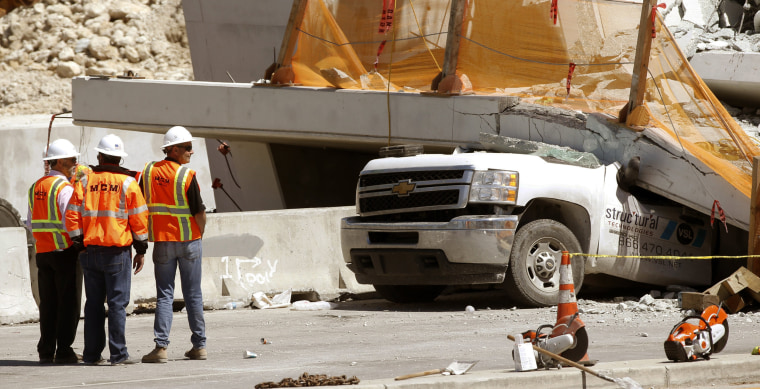Design errors in a 174-foot-long span of a pedestrian bridge that collapsed in Miami earlier this year, killing six people, were consistent with the cracking seen before the disaster, federal investigators said Thursday in a preliminary report.
The National Transportation Safety Board released the findings Thursday in a two-page investigative update and said the cause of the collapse has not been determined.
The Florida International University pedestrian bridge collapsed on March 15, crushing cars below. Six people died and eight others were injured. Five of the dead were occupants of vehicles; a bridge worker also was killed.
The NTSB said errors were made in the design of the “northernmost nodal region of the span where two truss members were connected to the bridge deck,” and that those errors resulted in an overestimation of the capacity and an underestimation of the load placed on that section.
The agency’s investigative update said that "the cracking observed in the node prior to the collapse is consistent with the identified errors."
The lead engineer of FIGG Bridge Engineers, the company that led the design of the walkway, left a voicemail with the Florida Department of Transportation about the cracks two days before the collapse.
But the message, left on a landline, was not heard until a day after the collapse because the employee it was intended for was out of the office on assignment, the department said in March. The voicemail said, in part, that "from a safety perspective, we don't see that there’s any issue there so we're not concerned about it from that perspective" but that it would have to be repaired, according to a transcript.
The Florida Department of Transportation in October acknowledged that the department employee returned from the assignment on the day of the collapse, before the bridge fell, but did not listen to the message until the day after, NBC Miami reported. The agency said in October that its original statement could have been worded better, the station reported.
"The investigation continues to examine the design, review, and construction processes as well as the actions taken once the cracking was observed," the NTSB said in the update Thursday.
The transportation safety board said the Turner-Fairbanks Highway Research Center, which is part of the Federal Highway Administration, conducted tests on concrete and steel samples taken from the collapsed bridge, and that those tests determined the samples did meet "the project's build plans specified minimum requirements."
The FIU pedestrian bridge was constructed with a relatively new form of construction known as accelerated bridge construction, a method designed to speed construction while maintaining safety.
One of those killed was Alexa Duran, 18, a freshman at FIU, who was driving from a doctor’s appointment when the bridge collapsed on her car. Her parents sued.
Their attorney, Alan Goldfarb, said the findings were "a good start" and confirmed what they suspected, which is there were design, engineering and construction flaws with the project.
"There are many, many professionals and workers who ignored the cracks ... and they failed to cry out to anyone to stop construction, and at the very least stop vehicular traffic," Goldfarb said. “That was the worst thing you can imagine, leaving that going."

A friend of Duran's, Richard Humble, who was inside the car but survived, has said they heard a creak overhead before the collapse.
"We tried to duck, but at the same time, it was just way too fast," Humble told "Today" a day after the collapse. "I screamed her name over and over again, but I didn't hear anything."
Other lawsuits were filed after the collapse, including by the family of truck driver Rolando Fraga, 60, who was also killed. An attorney in that lawsuit said the roadway should have been closed to traffic as work continued on the bridge.
The planned walkway connected the FIU campus to the town of Sweetwater, where the university estimates roughly 4,000 students live. It was expected to open in early 2019.
FIU said in a statement Thursday that it is fully cooperating with the NTSB investigation.
"We hope the results of the investigation will help bring closure to the families and loved ones of the victims," said Kenneth Jessell, senior vice president for finance and administration and chief financial officer.

